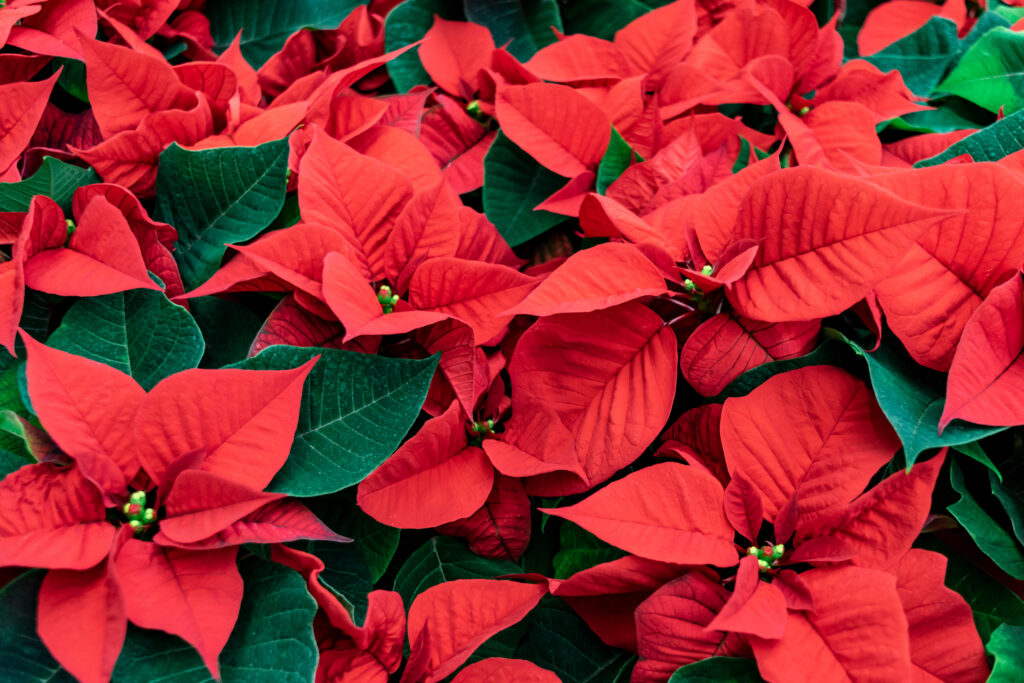
Features
Crop Protection
Flowers
Parvispinus on Poinsettias? It’s Possible.
What to watch out for, and potential management strategies.
April 3, 2024 By Sarah Jandricic, Greenhouse Floriculture IPM Specialist, OMAFRA
 Photo Credit: Adobe Stock/O de R
Photo Credit: Adobe Stock/O de R Growers in Ontario continue to struggle with Thrips parvispinus on tropical crops like mandevilla, anthurium and schefflera. Unfortunately, reports out of Europe also indicate this invasive pest species can also attack poinsettia.
Read on for what you need to watch out for, and potential management strategies.
The Issue
Although poinsettia (Euphorbiae pulcherrima) have not previously been reported as a host plant for Thrips parvipsinus (see https://mrec.ifas.ufl.edu/lsolab/thrips/thrips-parvispinus/ for all reported hosts), a grower in Europe was kind enough to reach out to me and send pictures of the damage he’s seen in this crop. Thrips parvispinus was confirmed as the culprit by local entomologists.
The damage looks much like “regular” thrips damage, from western flower thrips or Echinothrips (see this photo from U Mass extension.) However, as seen with T. parvspinus feeding damage on other crops, there is also lots of tissue distortion on new leaves.
Should I be Concerned?
Thrips parvispinus has been found in many countries at this point, and can likely be found in adjacent countries as well, even if it hasn’t been formally detected yet. Many of these countries supply poinsettia cuttings around the world. These include Spain, Guatemala and EL Salavador, as well as Kenya and Ethiopia (which are right next to Tanzania and Uganda, where T. parvispinus has been found).
However, just because a farm is located in a country, does not mean it necessarily has a Parvispinus problem. Indeed, the grower who sent me these pictures had not had a problem until recently. He strongly suspects the Parvispinus came from fly-ins from a surrounding pepper field, where the thrips were inadequately controlled. Although larvae were seen in the poinsettia crop as well, it’s unclear at this point if Parvispinus can complete their development on poinsettias (which would make the outbreak self-limiting, as long as there weren’t other host plants in the greenhouse).
So, at this point, we are simply recommending caution, some extra scouting of cutting materials, and some preventative treatments. Extra caution should be used if you are a tropical plant grower that also grows poinsettias, as we now know that Parvispinus could bounce from one crop into the other.
What Can I Do?
Early in the crop
Poinsettia cuttings should always be dipped in a combination of BotaniGard WP (2.5 g/L) and Suffoil X (0.1%) to reduce incoming populations of Bemisia whitefly. Luckily, this dip will also help combat Thrips parvispinus, as demonstrated by the Buitenhuis Lab at the Vineland Research and Innovation Centre. Suffoil X should be used over insecticidal soap, as work has shown that T. parvispinus comes in on other plant cuttings mostly as eggs, and oil dips can kill some of the thrips eggs, unlike soap.
If you scout the incoming cuttings and see evidence of heavy thrips feeding, see any dark thrips, or notice lots of distorted plant tissue, have any thrips identified by a consultant or entomologist. Or, attempt to identify them yourself using our simple thrips identification key for growers. If Parvispinus are confirmed or strongly suspected, it would be worth doing preventative pesticide sprays on the propagation bench, shortly after rooting.
The important thing will be to pick chemicals are less likely to be used again Bemisia whitefly (leading to potential resistance issues later in the crop), as well as chemicals with shorter residuals or that have low impacts on natural enemies for Bemisia, which are generally released at potting.
Chemical options include:
- Success (spinosad) – effective against adults and larvae of Parvispinus; low toxicity to parasitic wasps. Hard on predatory mites (e.g. Amblyseius for whitefly eggs) for up to 8 weeks.
- Kontos (spirotetramat) – effective against larval Parvispinus – low toxicity to parasitic wasps and mites if applied as a drench.
- Rimon (novaluron) – effective against larval Parvispinus – low toxicity to most bios.
- Lalguard M52 EC – effective against adult and larval Parvispinus – good compatibility with bios, but check for phytotoxicity on cuttings, as it is an oil formulation.
Later in the crop
In a perfect world, hopefully any Parvispinus issues you may encounter would be cleaned up in propagation. Further pesticide applications should be avoided in the potted crop until late September, to avoid shifting Bemisia communities towards the more resistant MED species (previously known as the “Q” biotype).
If you do need to spray, practicing proper pesticide rotation will be incredibly important in avoiding resistance issues in BOTH pests. Make sure to use insecticides from different chemical groups 5-7 days apart, and do not return to the first chemical group until a full generation of the pest has passed (e.g. 18-28d for Bemisia in warm weather).
Chemical options that have activity on both Parvispinus and Bemisia include:
- Altus (flupyradifurone) – Group 4D
- Beleaf (flonicamid) – applied as a drench – Group 29
- Ference (cyantraniliprole) – Group 48
- Kontos (spirotetramat) – applied as a drench -Group 23
- Rycar (pyrifluquinazon) – Group 9B
In previous years growers have noticed that tank mixes of these chemicals can improve control against Bemisia; this tactic may also offer improved control for T. parvispinus. However, tank-mixing regulations were changed in December 2023 in Canada. Read this blog post for how to determine if certain chemicals can be mixed or not.
Take Home Message
Thrips parvispinus are not a given in Poinsettia – at this rate, we don’t know how much they like this host plant, or if this is more of a “crime of opportunity”. However, given that Parvispinus has the potential to disrupt biocontrol programs for Bemisia whitefly in this crop, early detection and intervention will be critical.
Print this page